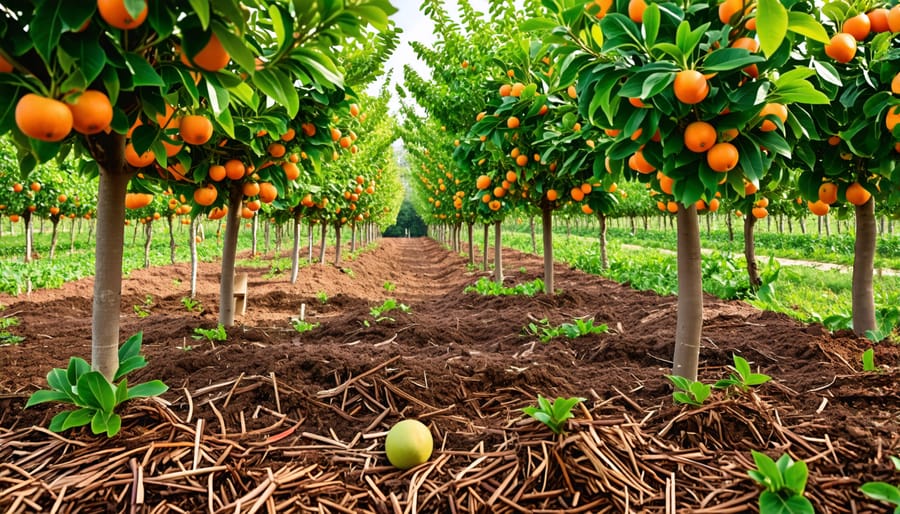Hidden Weed Invaders in Your Orchard: Banish Them for Good!

Post Content: Pull weeds by hand when the soil is moist, grasping at the base to remove the entire root system. Lay down a thick layer of organic mulch, like straw or wood chips, to suppress weed growth and retain moisture. Employ targeted applications of organic herbicides, such as vinegar or citrus oil solutions, to spot-treat persistent weeds without harming the environment. Cultivate the soil regularly with a hoe or cultivator to disrupt weed seedlings before they become established.

Preventive Weed Control Measures
Mulching Magic
Harnessing the power of organic mulches is a time-honored tradition that not only suppresses weed growth but also nurtures the very foundation of your orchard – the soil. Picture yourself strolling through your orchard on a warm summer day, the sun filtering through the leaves, and the rich earthy scent of mulch beneath your feet. It’s a sensory delight that speaks volumes about the love and care you pour into your land.
Organic mulches, such as straw, wood chips, or even homemade compost, create a protective barrier over the soil surface. This barrier acts as a guardian, shielding the soil from the harsh rays of the sun and preventing weed seeds from sprouting. It’s like tucking your soil in with a cozy blanket, providing a nurturing environment for your trees to thrive.
But the benefits of organic mulches go beyond mere weed suppression. As these natural materials break down over time, they enrich the soil with essential nutrients and improve its structure. This process is a beautiful dance between the mulch and the soil, working together in harmony to create a healthier, more vibrant ecosystem. By embracing the magic of mulching, you’re not only keeping weeds at bay but also investing in the long-term soil health of your orchard.
So, the next time you find yourself in your orchard, take a moment to appreciate the simple yet profound act of mulching. It’s a testament to your dedication and a reminder that sometimes, the most effective solutions are rooted in nature’s wisdom.

Cover Cropping Secrets
Harnessing the power of cover crops is a game-changer when it comes to weed control in your orchard. Picture a lush carpet of clover, rye, or hairy vetch blanketing the ground beneath your fruit trees. These living mulches act as natural weed suppressors, denying pesky invaders the space and nutrients they need to thrive. Not only do cover crops outcompete weeds, but they also enrich your soil with vital nutrients and organic matter as they grow and decompose. Talk about a win-win situation!
To get started, choose a cover crop that suits your orchard’s specific needs. Consider factors like the time of year, your climate, and the desired benefits. Once established, these green allies will work tirelessly to keep weeds at bay, allowing your fruit trees to flourish without the constant battle against unwanted vegetation. Plus, the sight of a vibrant, diverse understory adds a touch of natural beauty to your orchard landscape. Embrace the weed-smothering magic of cover crops and watch your orchard thrive like never before!
Precision Irrigation Tactics
Here are some precision irrigation tactics you can use to keep your orchard trees well-hydrated while discouraging weed growth. One of the most effective targeted watering techniques is using drip irrigation or soaker hoses. These deliver water directly to the base of your fruit trees, ensuring the roots get the moisture they need without wasting a drop on the surrounding soil where weeds might take hold.
You can also use mulch rings around your trees to further conserve moisture and suppress weed seeds. Apply a thick layer of organic mulch like straw, wood chips, or shredded leaves in a wide circle around each trunk. This will help retain water, moderate soil temperatures, and block sunlight that weeds need to sprout.
When irrigating, water deeply and less frequently to encourage your trees to develop extensive root systems. This allows them to outcompete weeds for water and nutrients. Use a moisture meter or dig down a few inches to check soil dampness before watering again. By being strategic with irrigation, you can maintain a lush, productive orchard while naturally keeping weeds at bay.
Effective Weed Removal Techniques

Hand Weeding Heroes
In the battle against weeds, nothing beats the satisfaction of getting your hands dirty and tackling them head-on. Hand weeding is a time-honored tradition that allows for targeted control in those hard-to-reach areas of your orchard. It’s a meditative process that connects you with the earth and your trees, fostering a deep appreciation for the delicate balance of nature.
To master the art of hand weeding, start by learning to identify common orchard weeds at various stages of growth. Equip yourself with the right tools, such as a comfortable kneeling pad, gloves, and a trusty weeding fork or hoe. Tackle weeds when the soil is moist, as this makes removal easier and ensures you get the entire root system.
As you work, take care not to disturb the delicate feeder roots of your fruit trees. Hand weeding allows for precision and care, ensuring the health and vitality of your orchard. Embrace the process, and you’ll soon find yourself lost in the rhythmic dance of plucking weeds and nurturing your trees, just as generations of orchardists have done before you.
Mowing Mastery
Mowing your orchard regularly is a simple yet effective way to manage weed growth and maintain a tidy appearance. The key is to strike a balance between controlling weeds and protecting your trees. Aim to mow when weeds are about 6-8 inches tall, which usually means every 2-3 weeks during the growing season. Avoid mowing too close to the ground, as this can damage tree roots and encourage new weed growth. Instead, set your mower deck to about 3-4 inches high. For young trees, be extra careful not to damage the tender bark with the mower or string trimmer. Consider using a mulch or weed barrier around the base of the trees to minimize the need for close mowing. For more on mower maintenance, you can refer to our guide on fixing a lawn mower that won’t start. Remember, consistent mowing not only keeps weeds in check but also helps prevent them from going to seed, reducing future weed problems in your orchard.
Organic Herbicide Options
For those seeking a more sustainable and eco-friendly approach to weed control in their orchards, organic herbicides offer a promising solution. These natural alternatives to synthetic chemicals harness the power of plant-based compounds to effectively suppress weed growth without harming the environment or your precious fruit trees.
One popular organic herbicide option is vinegar. The acetic acid in vinegar acts as a natural weed killer, causing the leaves to dry out and the plant to wither. For best results, use a higher concentration of vinegar (around 20%) and apply it directly to the leaves of the weeds on a sunny day. Just be careful not to get any on your trees!
Another effective plant-based herbicide is clove oil. This essential oil contains a compound called eugenol, which disrupts the cell membranes of weeds, causing them to dehydrate and die. Mix a few drops of clove oil with water and a little liquid soap (to help it stick to the leaves), and spray it on the weeds.
Corn gluten meal is yet another natural weed suppressant. When applied to the soil surface, it inhibits the germination of weed seeds, preventing them from sprouting in the first place. As a bonus, corn gluten meal also acts as a slow-release fertilizer, providing nutrients to your fruit trees.
Remember, while organic herbicides are generally safer than synthetic ones, they can still harm beneficial plants if used incorrectly. Always read the labels carefully and apply them with precision to target only the weeds, not your precious orchard trees.
Weaving Weed Control into Your Orchard Rhythm
Integrating weed management into your regular orchard care routine is key to maintaining a healthy, productive orchard. By adopting a proactive approach, you can prevent weeds from taking hold and minimize the time spent on control measures. Start by regularly monitoring your orchard for signs of weed growth, especially during the spring and summer months when weeds tend to thrive.
When mowing or trimming the grass between your fruit trees, be careful not to damage the tree trunks or shallow roots. Consider using mulch around the base of your trees to suppress weed growth and retain moisture in the soil. Organic mulches, such as wood chips or straw, can also improve soil structure and fertility as they break down over time.
If you notice weeds starting to emerge, deal with them promptly before they have a chance to establish deep roots or spread seeds. Hand-pulling or hoeing can be effective for small weed patches, while larger infestations may require the targeted use of organic herbicides or weed-suppressing ground covers.
Remember, consistent and timely weed control efforts are more effective and less labor-intensive than tackling large weed problems once they’ve gotten out of hand. By weaving weed management into your regular orchard care routine, you’ll create a more sustainable growing environment that supports the long-term health and productivity of your fruit trees.
